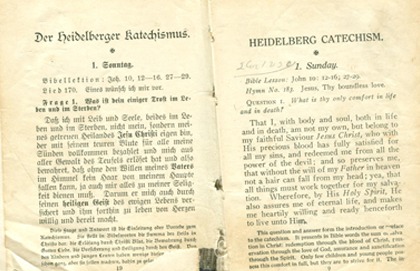This article is a follow-up to "A Pilgrimage of Conversation" (Convivium, April-May 2015), which described the portrayal by Geoffrey Chaucer of the enduring togetherness of the pilgrim fellowship in The Canterbury Tales. Chaucer encourages his audience and readers to contemplate what it is that we owe one another if we can imagine a solidity or depth of being in one another that no amount of failure can eradicate (the imago Dei). As an artist committed to showing rather than telling, he can do so only by demonstrating precisely such failures. Enter the pilgrims, themselves tale-telling artists, with their shameless attempts to humiliate one another and, above all, to claim the last word. They stay together nonetheless, almost involuntarily bearing witness to resonating with "the interdependent life of a universe that is addressed and sustained by a Word from God," as Rowan Williams notes in Dostoevsky: Language, Faith, and Fiction.
It is not, however, Chaucer's ideal that members of the pilgrim fellowship (which after all symbolizes the Church) should treat one another in such ways. He would have all pilgrims more intentionally participate as artists in this life sustained by the Word. The essence of living life as an artist is to allow the revelatory fullness of Christ to shine forth in the particularities of one's own existence. This vocation means responding to the call of the Gospel – the demand for obedience – in the specificity of one's own life situation. In this way, through interpretive, obedient responsiveness to God, the person (and, for Chaucer, more typically, the community) reconciles the unity of truth and the difference (or uniqueness) of historical being.
The medieval English poet's preferred example of those who do this effectively are the Gospel writers, who obey the call to write down the story of the life, death and Resurrection of Christ. Chaucer says of them that they all have the same message while each tells the story differently:
"Ye woot that every Evaungelist
That telleth us the peyne of Jhesu Crist
Ne seith nat alle thyng as his felawe dooth,
But nathelees hir sentence is al sooth,
And alle acorden as in hire sentence,
Al be ther in hir tellyng difference.
For somme of hem seyn moore and somme seyn lesse
Whan they his pitous passioun expresse –
I meene of Mark, Mathew, Luc, and John –
But doubtelees hir sentence is al oon."
(You know that every Evangelist
That tells us the pain of Jesus Christ
Does not say everything as his fellow does,
But nonetheless their meaning is all the same,
And all agree as in their meaning,
Even though there is in their telling difference.
For some of them say more and some say less
When they his piteous passion express –
I mean of Mark, Matthew, Luke, and John –
But doubtless their meaning is all one.)
Chaucer adheres to the principle that the different Gospel writers bear witness to the same truth in their own unique way and imitates this reconciliation of unity and difference. One index of this commitment is the way he embodies this paradox in his own poetic style. Chaucer performs the dance of particularity interwoven with unity. First he draws attention to "every Evaungelist," alliteratively emphasizing their plurality, while in the next line he refers to their common message: "the peyne of Jhesu Crist." Alison Milbank has pointed out to me that, in rhyming "Crist" with another word (here "Evaungelist"), he does something Dante never allowed himself to do. Chaucer is pressing what it means to believe that everything finds its being in Christ by "rhyming" with him.
In the next rhyming couplet, or pair of poetic lines, Chaucer repeats the pattern. First he recognizes plurality: "Ne seith nat alle thyng as his felawe dooth"; then he affirms that their "sentence" (that is, the gist of what they are saying) is all the same ("sooth"). The alliteration of ne, nat and natheless both reinforces difference (ne, nat) and restores unity (natheless). In a chiasmic X structure, Chaucer then flips the order, going from unity to difference in the following couplet: "And alle acorden as in hire sentence" repeats the emphasis on unity from the previous line, while the subsequent line affirms difference. This couplet also cheekily draws attention to the fact that two words that seem philosophically to represent opposite poles, sentence and difference, actually rhyme.
In the next two couplets, Chaucer reverts to the pattern of preceding unity with difference. First we get a series of sliding sibilants: "For somme of hem seyn moore and somme seyn lesse." One can feel the line slipping away from one's control as the S's slide out of the mouth. Then Chaucer focuses pointedly on Christ's "pitous passioun," the plosive P sound grounding the line as the Incarnation grounds all reality. The phrase following, "I meene of Mark, Mathew, Luc, and John," reminds the audience of the manifold Gospel writers, their difference reinforced by the alliterative M's that, like the S's, resist containment. Then, like the P, the voiced declarative quality of B and D in the phrase "But douteless" pulls the poetry up short. Chaucer ends the sequence with the faith statement that the Evangelists' meaning is all "oon." The poetic combination of content and form displays a high level of both artistic and theological craftsmanship.
Chaucer shows his readership, in Heavenly Participation, that in reality, one cannot sever the two categories of art and theology. Hans Boersma writes that "the one and the many [go] back to the heart of who God is" in explaining the importance of Trinitarianism. Chaucer agrees (despite the difference of his time and place). The reconciliation of unity and difference is important ontologically – that is to say, in terms of our understanding of being. This reconciliation is modelled performatively in God's self-revelation in Christ; historically, it issues in the Church's credal affirmation of the Trinitarian reality.






